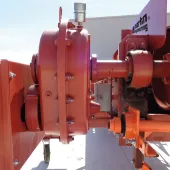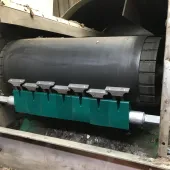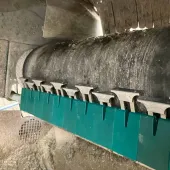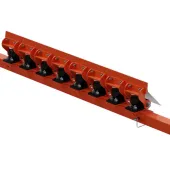Martin Engineering introduce secondary conveyor belt cleaner
Latest SQC2S cleaner designed to offer improved performance and safety and reduced maintenance
MARTIN Engineering have launched a secondary conveyor belt cleaner developed to improve performance and reduce maintenance time, even as average belt speeds and loads continue to increase.
The new SQC2S cleaner features individually cushioned tungsten carbide blades for effective cleaning without risk to the belt or splices. The new design forms a single sealing edge that maintains steady, adjustable pressure. Patented rubber buffers maintain the cleaning pressure throughout the blade’s life, while deflecting sufficiently to allow splices to pass without harm and ensuring compatibility with reversing belts or those that experience backup at shutdown. Moving parts are zinc plated to resist seizing or rusting.
‘The blades conform to the belt profile, adjusting individually to deliver continuous contact across the belt,’ explained Dave Mueller, senior product specialist at Martin Engineering. ‘In a perfect world, bulk materials would load uniformly, wearing the blade evenly, but that rarely happens. By having multiple segments attached to a single rigid assembly, the tension can be maintained and adjusted accurately, quickly and safely.’
The rugged construction is engineered to withstand demanding conditions, such as high belt speeds, high-impact transfers and high tonnage loads. Designed for a maximum belt speed of 5.08 m/sec, the cleaner is suited for belt widths from 18in to 96in
To match the requirements of specific applications, the unit features straight 5.91in individual blade sections or 3in individual blade sections, attached to a sturdy square mainframe. Replaceable urethane blades are color-coded according to their continuous temperature rating, ranging between -40 degrees to 177 degrees Celsius.
Tungsten carbide tips can be specified for normal, acidic or high-impact conditions. The rubber wear strip is supplied in continuous lengths up to 100ft. Blade removal and replacement is a simple operation on the SQC2S by removing the lock pin from the main assembly and sliding out the cartridge. The lock pins are a key component to Martin Engineering’s ‘no-reach design’, which allows workers to conduct their lockout/tag-out procedure more safely.
‘We work with all types of bulk material, from biomass to aggregates to sticky sand, each with different requirements,’ said Mr Mueller. ‘Therefore, our products are developed to improve efficiency and safety, without compromising belt health. This design gives customers more options, regardless of the nature of the bulk material being conveyed.’









